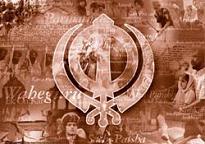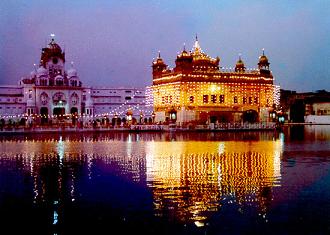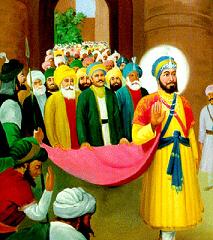
 |
Sikh Missionary Society U.K. (Regd)
10, Featherstone Road.
Southall, Middx, U.K. UB2 5AA
Tel: +44 020 8574
1902
Fax: +44 020 8574
1912
Reg Charity No: 262404
|
||
|---|---|---|---|
|
|
|||
Festival of Lights

This day is the commemoration of the return of Shri Ram Chandar from his exile from Ayodhya. He was to spend fourteen years in the forests etc. This was in accordance with the dictates of his step mother Kakkai so that her real son Bharat could be throned. Thus goes the story that is about ten thousand years old. This is an important festival for the Hindus. It is also a seasonal festival indicating onser of the winter.
Diwali and Baisakhi had been very importnt in the Sikh world. On these days, the Sikhs gathered at Akal Takht as Sarbatt-Khalsa (all the Sikhs) to take important decisions to direct the the Sikh world. All the heads of the Sikh Missals (principalities) gathered here forgetting their mutual animositie, and took unanimous decisions for their strategies to protect and promote the faith and to unitedly fight opressors and for the liberty. These decisions were a binding on every Sikh, and were religiously followed.
Bhai Mani Singh decided to celebrate Diwali at Darbar Sahib (Harimandir Sahib), Amritsar, and agreed to pay rupees 5,000. This was a huge amount in those days. Lakhpat Rai, under the directions of Zakria Khan, attacked Harimandir Sahib Diwali night. Due to this attack, Bhai Mani Singh failed to collect and pay the amount. Zakria Khan, Governor Lahore, ordered to cut him joint by joint. Ahmed Shah Abdali destroyd this holy place - source of the Sikh inspiration, agin and again.
Also read `Mani Singh,' `Ahmed Shah Abdali,' `Zakria Khan,' and `Nadar Shah,' in `Betwen the Lines.'
The Sixth Guru Hargobind, who had a cavalry of two thousands, went out hunting, encouraged war-games, had a Nakkarah (Nagara, kettledrum) an ensign - the Sikh flag, and held his court. He conducted himself like a king, and it was an irritant to the rulers.
Chandu, Prithi Chand and his son Meharban, and others harbored animosity with the Guru. They kept instigating the Mogul Emperor Jahangir who found that his murdering Guru Arjun father of Guru Hargobind, had made Sikhs more bold rather than subjugating them.
 King
Jahangir invited the Guru through Wazir Khan and Guncha Beg, to meet him
at Delhi. The King was impressed to see him, but the fear of the building
up power of the Guru had upper hand, and he put him under housearrest in
the fort at Gwalior. Jahangir pretended that he desired the Guru to stay
at a secluded and calm place to pray for the relief of his (King's) afflictions.
King
Jahangir invited the Guru through Wazir Khan and Guncha Beg, to meet him
at Delhi. The King was impressed to see him, but the fear of the building
up power of the Guru had upper hand, and he put him under housearrest in
the fort at Gwalior. Jahangir pretended that he desired the Guru to stay
at a secluded and calm place to pray for the relief of his (King's) afflictions.
In the fort, fifty-two Rajas were as the prisoners. The Guru had special arrangements for his food. He would give all his superior rations to the Rajas and would himself eat the meals prepared by his ordinary devotee. There is a memorial in the fort where the Guru used to pray. There, the Sikhs occasionally, and Muslims pray every Thursday evening. (Macauliffe, S.Chand & Co, New Delhi, 1963. Vol: IV, page 27).
Chaukian - the Sikh Vigils. The Sikhs were distressed by the news of arrest of the Guru. Even the God fearing Muslims had their resentment along with the Sikhs. To express their grief and concern the Sikhs started Chaukiaan - circumambulation carrying torch lights, the Sikh flags, and singing the Holy Hymns, around Harmandir Sahib and in the city of Amritsar,. The Sikhs would go in batches from the Punjab, go around the fort at Gwalior, bow in the direction of the Guru's residence and come back.
Release of the Guru - Saint Mianmir had laid down the foundation stone of The Golden Temple. He was a Muslim holyman and Jahangir had great faith in him. Jahangir's wife Noor Jahan, was disciple of this holy man. She had influenced Jahangir not to be so fanatic. Wazir Khan also revered the Sixth Guru. They both and other right thinking people prevailed upon the King and got release orders for the Guru. The Guru came out only when other fifty two Rajas under arrest there, were allowed to come out with him, holding fifty tips of his long Cholaa - cloak, and his hands. This Chola was specially prepared for this pupose to fulfil the King's condition that all those who could hold the Guru, would be allowed to go out. Since that day, the Guru came to be known as �Bandi-Chhor� - the Deliverer. It was Diwali-day when he returned to Amritsar, and it became an occasion of rejoicing for the Sikhs. The Guru stayed in the fort for about two years.
| Previous Chapter - Bird�s Eye View |
Next Chapter - Baisakhi
99
|